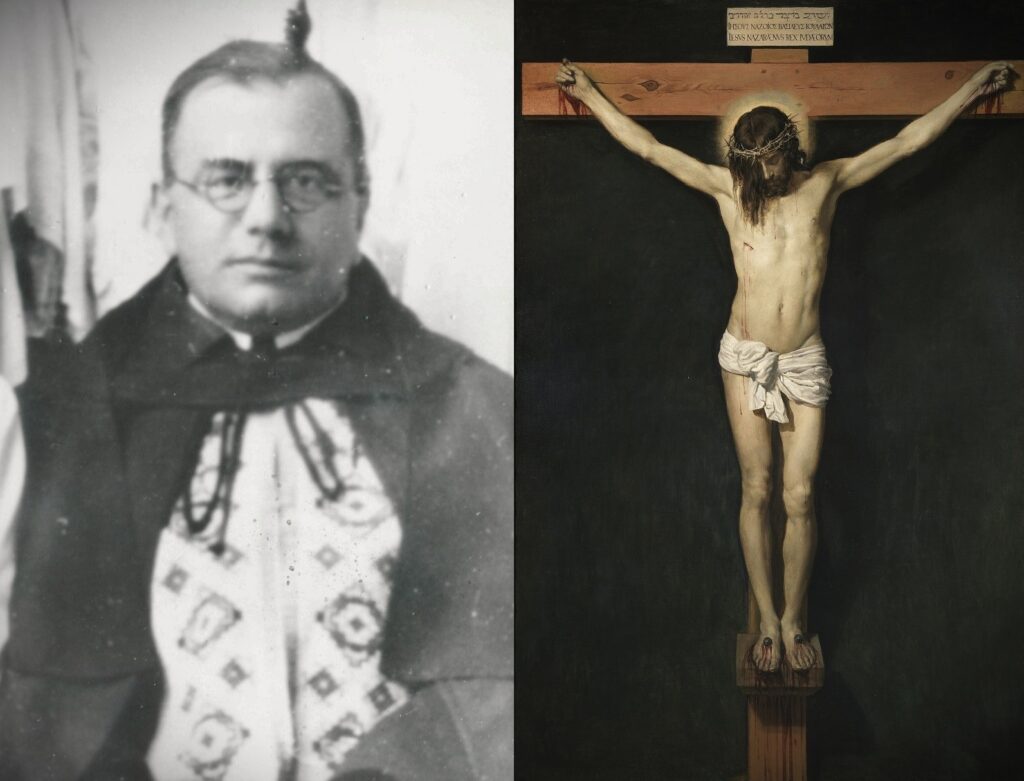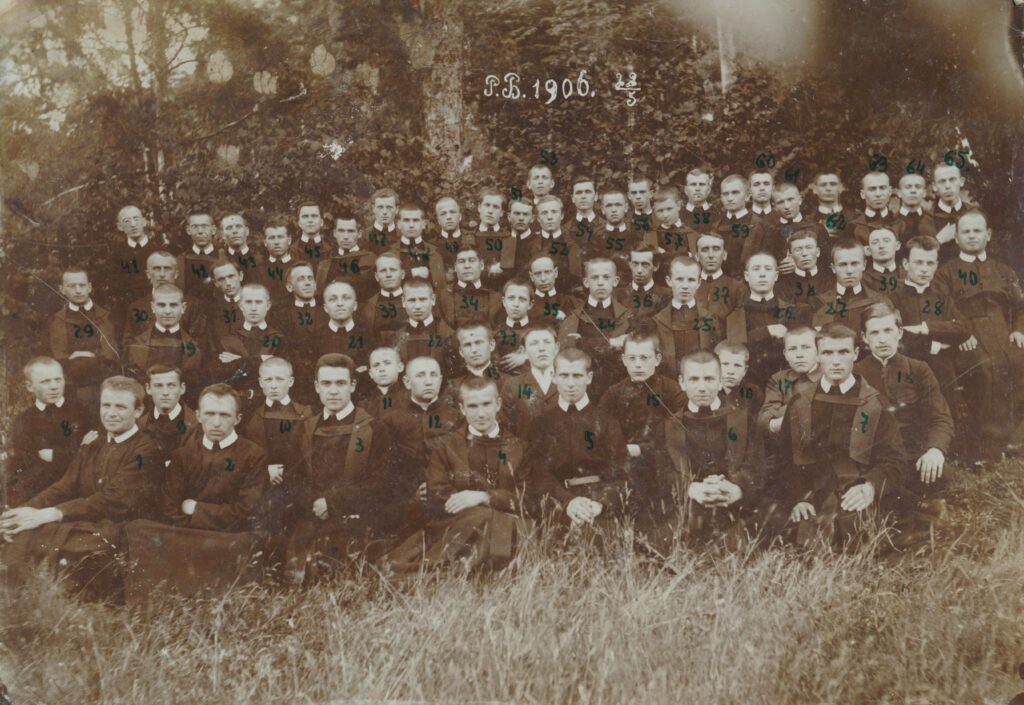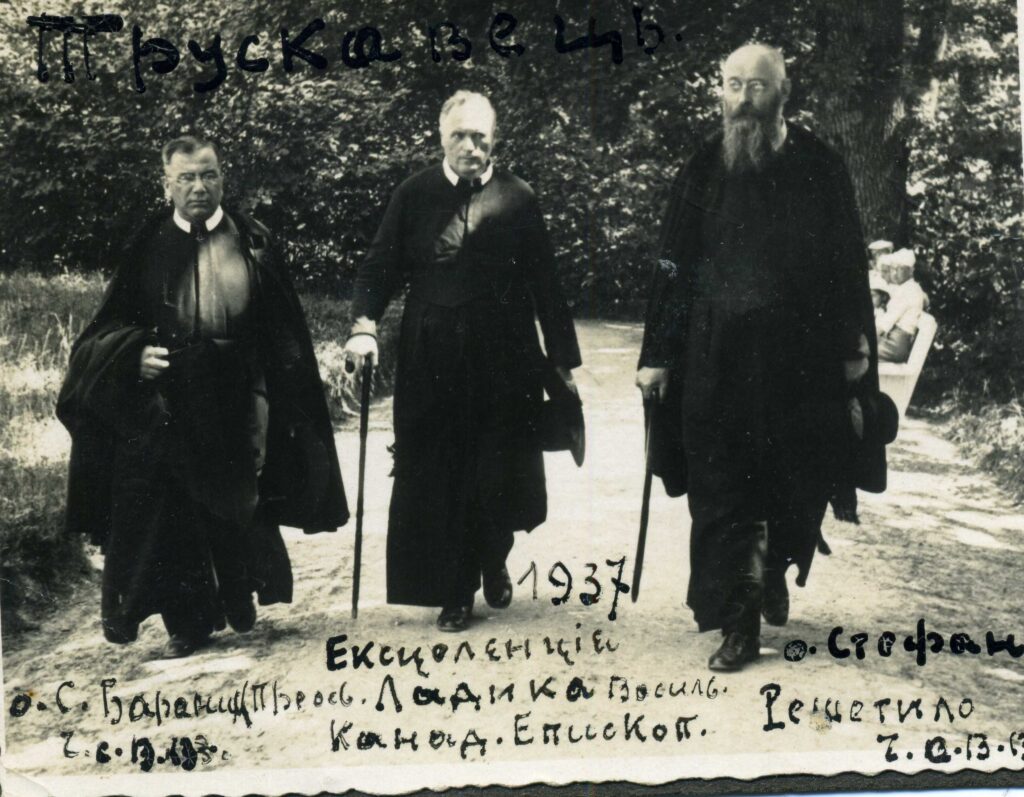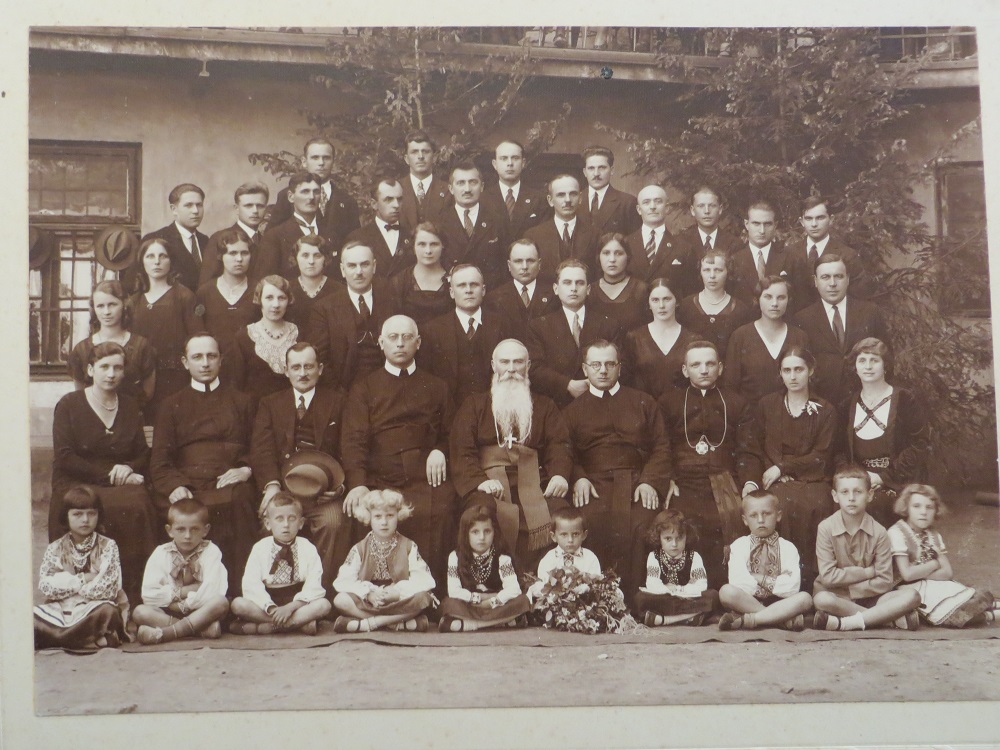Hieromartyr Severian Baranyk – Cross-Bearing Witness of the Crucified Christ

He was a true cross-bearer — not only in the spiritual sense, but literally, for the hand of an NKVD (KGB) torturer carved the sign of the cross into his chest. Just as the high priest Caiaphas once prophesied about Christ while plotting His death, so too the godless persecutor unknowingly revealed the truth about this victorious servant of God — a man who, from youth, chose to follow Christ, dedicated his young life to Him in the quiet of a monastic cell, preached Him for the salvation of others, never betrayed or denied Him, and finally carried His Cross to his own Golgotha. This is recounted in an article in the magazine “Christian and the World”.
Uhnev is the smallest and perhaps the most unnoticed town in Ukraine. It rests in a beautiful forested region of the Sokal district in the Lviv region, just a short distance from the Polish border, on the banks of the Solokia River which flows into the Bug. Yet, it was here that one of its sons — from a town untouched by serfdom through the centuries — was destined to confess his faith and love for God not only in word but in life itself, choosing martyrdom rather than slavery to sin.
This witness of Christ was Stepan Baranyk (later Fr. Severian), born July 18, 1889. He grew up in the devout and prosperous family of Mykola and Anna Baranyk, with five children — three sons and two daughters. The parents spared neither effort nor expense in their children’s education, raising them in a deeply Christian and patriotic spirit.
Childhood, Education, and the Awakening of Vocation
In 1898, when Stepan turned nine, he began his studies at the Ukrainian Boys’ School in Uhnev. From 1900 to 1903, he studied at the Ukrainian State Boys’ Gymnasium in Peremyshl, where the director was the highly educated pedagogue Hryhorii Tsehlinsky. He was known as a sincere father and benefactor of youth, devoted to assisting students both materially and in their formation. His goal was to provide the Ukrainian nation with educated, responsible, and creative citizens.
From Stepan’s academic record at the Peremyshl Gymnasium we learn that, by his fourth year of studies, he was already entrusted with tutoring two children of Fr. Volodymyr Lototsky, the parish priest of Povytno (Horodok region). This fact attests to the boy’s intellectual gifts: he was not only able to master knowledge himself, but also to teach and inspire younger students, drawing them into the pursuit of wisdom and the mysteries of learning.
Although Stepan enjoyed teaching, he sensed within himself a call to something greater — a complete dedication that would allow him to proclaim the truth and the knowledge of God more widely. He could not yet fully discern to what mission the Lord was calling him. He continued his gymnasium studies, assisted his parents, taught others, and waited patiently for clarity regarding his path in life.
A decisive turning point came after he completed gymnasium. At age fifteen, Stepan felt a profound and unmistakable movement of divine grace. God called him to “leave the world” and consecrate himself entirely to the Lord. Already then, the Lord was preparing the soul of His chosen servant for the future total offering of martyrdom. Though only fifteen, his desire for self-denial, perfection, and following Christ — his longing to bring the Good News to others — was so strong that it compelled him to leave his home, his loving parents, and his siblings for the sake of the Kingdom of God. He seemed to sense that time was short — that life would not be long.
On 24 September 1904, Stepan Baranyk entered the Basilian novitiate in Krekhiv, beginning his monastic journey — the path that would lead him through Golgotha to the light of Resurrection.
Metropolitan Yosyf Rutsky described the mission of Basilian monks in the Church and society in these words:
“Monks will distinguish themselves by learning and holiness of life. We will have good confessors and preachers, which we have lacked until now. We will found many well-organized schools, from which will come good parish clergy and also statesmen. To the episcopal office will rise men who know their duties. In this way we will also be able to help our brethren of the same rite.”

These directives were in harmony with the aspirations of Stepan Baranyk. He desired to grow in virtue, to strive for holiness, to be educated and prepared for any mission required by the Church. And so, he knowingly chose the path of monasticism.
The Basilian Novitiate and the Dobromyl Reform
In 1902, construction of the new monastery in Krekhiv was completed, and its consecration was performed on 29 September of that same year by Metropolitan Andrey Sheptytsky. The hegumen (superior) of the monastery at that time was Fr. Yeronim Malytsky. The novitiate was transferred here from Dobromyl, and the first novice master of the reformed Basilian Order, following the Dobromyl Reform, was Fr. Dionysius Tkachuk.
It is worth recalling that in the 19th century, due to various political and social circumstances, the Basilian Order fell into crisis. On Russian-controlled territory it was completely and definitively liquidated. Only within the borders of the Austro-Hungarian Empire did the Order continue to exist, though not without significant difficulties.
In the second half of the 19th century, Pope Leo XIII initiated a reform of the Order, entrusting the Jesuits with the task of renewing and reorganizing Basilian monastic life until a new, well-formed generation of monks could be established. The center of this reform, begun on 12 May 1882, was the monastery in Dobromyl, from which the movement took its name — the Dobromyl Reform.
The results of this reform soon became evident: it gave rise to a number of distinguished figures who developed missionary work, spiritual renewal, pastoral and publishing activity, as well as scholarly research. Among these reformed Basilians emerged prominent hierarchs of the Ukrainian Greco-Catholic Church — Metropolitan Andrey Sheptytsky, Bishop Soter Ortynsky, and Bishop Josaphat Kotsylovsky.
The Krekhiv novitiate formed new vocations according to the constitution of the Order, maintaining the discipline established by St. Josaphat, fidelity to the Byzantine (Ruthenian) liturgical tradition, and observance of the fasts prescribed by St. Josaphat. In 1902, there were only eight monks in Krekhiv — three priests and five brothers. But already the following year, that number rose to sixty-two: eight priests, thirty-five seminarians, and nine brothers.
It was into this newly reformed novitiate that the young Stepan Baranyk entered, and with the monastic habit he received a new name — Severian.
On 16 May 1907, after completing the novitiate, Brother Severian professed his first monastic vows: poverty, chastity, and obedience. On 21 September 1910, at the age of twenty-one, in the monastery of St. Onuphrius in Lavriv, he professed his perpetual vows and consecrated himself entirely to God.
Afterward, Brother Severian returned to Krekhiv to continue his studies. On the eve of the First World War, the Galician Province of the Basilian Fathers already numbered sixteen monasteries and two foreign missions, with a total of 234 monks.
World War I, Exile, Ordination, and Early Ministry
In 1914, peaceful monastic life came to an end for Brother Severian and his confrères. “Russia attacked Austria and occupied Halychyna. Then Protohegumen (Provincial Superior) Platonid Filias evacuated the clerics studying theology to Croatia, where they were able to complete their theological formation” (as recalled by Fr. Damian Bohun). Among those monks was Severian Baranyk.
After completing his philosophical and theological studies, he received the Holy Mystery of Priesthood on 14 February 1915 in Zagreb at the hands of Bishop Dionisiy Nyarádi. The following day — 15 February 1915, on The Presentation of Our Lord (Stritennia), he celebrated his first Divine Liturgy in Varaždin.

In late 1916, political circumstances improved, and Fr. Severian, together with other Basilians, was able to return to his homeland. After his return to Ukraine, he was assigned to the monastery in Zhovkva. At that time, the monastery community numbered eighteen monks: eight priests and ten brothers.
After morning communal prayer and meal, each monk would go to his appointed duty. Fr. Severian served especially in parish ministry with children and youth.
This was not a peaceful time. The Ukrainian-Polish war of 1918–1919 brought great destruction, affecting not only individual monastic houses but entire religious communities. The monasteries of Krekhiv and Zhovkva suffered the most.
On 19 May 1919, the Polish authorities arrested and imprisoned forty-two Basilian monks in the internment camp in Dombiu (near Kraków), where they remained until 4 August of the same year. Among them was Fr. Severian.
Through the intervention of Bishop Josaphat Kotsylovsky, Jesuit Fr. Rostworowski (rector of the Kraków theological seminary), and especially the Apostolic Nuncio in Warsaw, Achille Ratti (later Pope Pius XI), the Basilian Fathers — including Fr. Severian — were finally released from internment.
Upon returning to Zhovkva, Fr. Severian continued his ministry among the faithful. He dedicated all his time generously to those in need of counsel, encouragement, or prayer. He was always ready to listen and offer help. Children especially loved him, and he cared for them as a true spiritual father.
During the First World War, many children were left orphaned, and under the patronage of Metropolitan Andrey Sheptytsky, committees for the protection of orphans were formed throughout the eparchies. The Zhovkva monastery had its own home for orphans and the elderly, and the monks cared for them. Fr. Severian served as the superior of this orphanage.
Catechist, Preacher, Editor, and Spiritual Father of Youth
As a catechist in the school, Hieromonk Severian taught children the truths of the faith, especially encouraging them to come to know God’s love and to respond to it. His own example often served as a living lesson for the faithful.
Already in 1895, a printing press had been established at the monastery in Zhovkva, which published religious, educational, and popular literature. Fr. Severian became editor of the non-political, religious-educational monthly periodical “Nash Pryiatel” (“Our Friend”), intended for the children and school youth of the Greek-Catholic Church.
Besides catechetical work, Fr. Severian also led the Marian Sodality for both youth and craftsmen, as well as the Association of the Apostleship of Prayer for a Holy Death. He preached conferences for the monks and conducted spiritual retreats for the faithful.
Those who knew him remembered him as a man always joyful, kind, sincere, and approachable, yet also deeply responsible and diligent in fulfilling his duties. He brought consolation to others quietly and humbly, without self-display, laboring sacrificially in God’s vineyard.
Fr. Severian Baranyk was also one of the co-founders in Zhovkva of the Ukrainian Catholic Youth Association “Zhyttia” (“Life”), whose purpose was to form out-of-school youth in faith and morality, in love for the homeland and national traditions. The association also promoted sobriety, industriousness, culture, and honesty among young men.
Transfer to Drohobych
In 1932, Fr. Severian was transferred to Drohobych and appointed hegumen (superior) of the monastery of the Holy Apostles Peter and Paul, as well as pastor of the parish church of the Holy Trinity. This monastery was one of the most significant spiritual centers of Halychyna.
Until the arrival of the Soviet regime in 1939, the monastery was a model of active parish ministry. Under its care were seven churches in Drohobych itself and one in the nearby village of Lishnia.
Awaiting Fr. Baranyk in Drohobych were many labors — and many joys — but no one could have foreseen that it would be there that his earthly life would come to an end in martyrdom.
Fr. Severian served as a catechist and teacher at the Drohobych Gymnasium, and youth always remained the special field of his pastoral concern. A great friend of the young, he took interest not only in their spiritual life, but also in the sporting and cultural life of Drohobych and its surroundings.
From 1932 to 1939, he served as vice-president of the Drohobych branch of “Prosvita”, the cultural-educational society. On the eve of the war, the local chapter of “Prosvita” focused its efforts on self-education circles. Young people gathered in reading rooms to study the history of Ukraine, literature, geography, and other subjects of Ukrainian studies.
Soviet Occupation, Hidden Ministry, and the Approach of Martyrdom
In September 1939, Soviet troops occupied Western Ukraine. With the arrival of the Red Army, visible church life appeared to fall silent, yet spiritually it only deepened and grew in intensity. Fr. Baranyk continued his pastoral work in Drohobych. Though the times were uncertain, the Fathers continued tirelessly to serve the spiritual needs of the faithful: they heard confessions, administered the Holy Mysteries, and gave retreats.
It was at this time — in 1939 — that Fr. Yakym Senkivsky was assigned to assist Fr. Severian. This priest, who soon became not only his confrère and co-worker, but eventually his co-martyr, enriched Drohobych with yet another powerful preacher. Before long, the two priests became known among the people as the “Basilian Chrysostoms” — golden-mouthed preachers.

Metropolitan Andrey Sheptytsky clearly understood the danger that had come upon the Church with Soviet rule, and foresaw its consequences. He harbored no illusions regarding the new authorities, as is evident from his 1941 letter to the Holy Father: “The Bolsheviks are the most relentless enemies of Jesus Christ, of His Church, and of all religion and spirituality. From their actions we were convinced that in just a few years, under such a regime, not a trace would remain of clergy, churches, or faithful in our land. They clearly intended to destroy to its foundations everything that is Christian among us.”
In Drohobych, the NKVD (KGB) forbade Hieromonks Baranyk and Senkivsky to leave the monastery, using the pretext of wartime restrictions. In spite of this, the Fathers continued their pastoral ministry for the good of souls. Yet dark clouds were already gathering over them. Faithful parishioners pleaded with the priests to leave the monastery temporarily to escape persecution, but the monks refused. They answered: “If they do not find us here, they will take revenge on the innocent. Better that we should suffer.”
The Soviet Retreat and the Arrest
By late June 1941, as the German army advanced into Soviet-occupied territories — Ukraine among the first — the Soviet authorities, rather than organizing military defense, focused on eliminating thousands of Ukrainians, especially the educated classes.
On the morning of 26 June 1941, Frs. Severian and Yakym celebrated what would be their final Divine Liturgy. Around midday, NKVD (KGB) agents arrived, arrested them, and took them to the Drohobych prison. They were seized like the most dangerous of criminals — without trial or investigation. No one ever saw them alive again.
According to testimony, Fr. Severian Baranyk was tortured to death — the executioners cut the shape of a cross into his chest. Fr. Yakym Senkivsky, it is said, was boiled alive in a prison cauldron.

Mrs. Sofiia Morska later recalled that years after the war, a former prosecutor described to her the atrocities committed in the prison: one priest was boiled in a vat and fed to prisoners; others were buried up to their necks in the ground, and guards walked upon their heads; still others endured unspeakable tortures. The burial place of Hieromonk Severian remains unknown, though many testimonies suggest he was thrown into a mass grave near the cemetery on Mykhailo Hrushevskyi Street in Drohobych.
Reburial of the Victims
Half a century later, on 14 July 1991, in Drohobych, at the Field of Sorrows, a solemn reburial took place for 486 victims of Bolshevik terror (1939–1941). At the head of the funeral procession, the people of Drohobych carried symbolic coffins representing the hegumen (superior) of the Holy Trinity Monastery and parish priest of the same church — Hieromonk Severian Baranyk — and his co-laborer, the outstanding missionary, preacher, and professor — Hieromonk Yakym Senkivsky.
Legacy and Veneration
The life of Blessed Hieromartyr Severian Baranyk, who from his youth consecrated his life to God, was so quiet and humble that it left behind few earthly traces or material testimonials. He worked tirelessly in the vineyard of the Lord, expecting no earthly reward. A zealous monk, golden-mouthed preacher, self-sacrificing priest, guardian of orphans and children, mentor and friend of youth, always ready to assist those in need — such is the image of Blessed Severian preserved in the grateful memory of the faithful.
He did not abandon his flock. He chose instead to lay down his life, sealing his fidelity to Christ with martyrdom. Today he intercedes tirelessly for us.
Blessed Hieromartyr Severian, in our hearts lives the memory of your martyrdom for Christ. You remained faithful to the Lord to the end. Pray that we may follow in your footsteps, and like you, remain faithful to Christ unto the end.
Sr. Ignatiia Havrylyk, OSBM
Sr. Nataliia Styranets, OSBM
BIBLIOGRAPHY
Archival sources:
- Архів Отців Василіян Львів, свідчення о. Дам’яна Богуна, ЧСВВ про о. Северіяна Бараника, ЧСВВ.
- Історичний архів отців василіян у Римі. Жидан Ілярій, Воєнний записник.
- Особові справи Блаженних з архіву Місії «Постуляційний центр беатифікації й канонізації святих УГКЦ».
- ЦДІАЛ, Ф. 684, Опис 1, Справа 497 – монах Бараник Степан, 8 липня 1900 – 21 вересня 1910, на 10 аркушах.
Published sources:
- Mattei Giampaolo, Ucraina terra dei martiri, L’eroica testimonianza dei beati proclamati da Giovanni Paolo II a Lviv durante lo storico pellegrinaggio, Quaderni de “L’Osservatore Romano”, №61, Città del Vaticano 2002, 121-127;
- Боцюрків Б. Українська Греко-Католицька Церква і Радянська держава (1939-1950). Львів: УКУ, 2005.
- Ваврик М. По Василіянських монастирях. Торонто, 1958.
- Гаврилів Н., Блаженний священномученик Северіян Бараник, ЧСВВ. Угнів, 2011.
- Добромильська реформа і відродження Української Церкви. Доповіді та матеріяли учасників Міжнародної наукової конференції / упорядник Михайло Гайковський. – Львів: Місіонер, 2003.
- Лебедович І., о. Полеві духовники Української Галицької Армії, У 45-річчя участи у визвольних змаганнях. Матеріали до історії. Вінніпег, 1963.
- Нарис історії Василіянського Чину Святого Йосафата / Записки ЧСВВ // Рим, 1992. – Серія ІІ.
- Підручний П., о. ЧСВВ. Два програмові писання Рутського: «Discursus» і «Programa Unionis», Analecta Ordinis s. Basilii Magni / Рим, 1974. – Серія II, т. IX.

 Basilian Order of Saint Josaphat
Basilian Order of Saint Josaphat 

